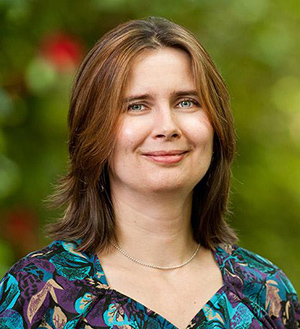
Physics graduate student Carly Fengel shows a Timber Ridge Elementary School student the beautiful spectral lines of hydrogen, helium, argon and neon lamps. When viewed through diffraction grating glasses, the various wavelengths of light are split apart, revealing a unique signature for each gas. “So we could tell what stars are made of!” remarked the student.
Family Science Nights have been a yearly staple in Corvallis schools for more than a decade, but May 16 was only the second one for Timber Ridge School, a combined middle and elementary school serving a rural area on the northern edge of Albany. About 200 students of all ages attended the event, with middle-school students acting as guides and selling snacks as a fundraiser.
In addition to volunteers from the physics department, OSU was represented by other departments, including the College of Veterinary Medicine, the College of Earth, Ocean, and Atmospheric Sciences, and the School of Nuclear Science and Engineering. Non-departmental groups also showed up, such as the Dairy Club, Geology Club, and Fisheries and Wildlife Club. For the first time, nursing students from Linn-Benton Community College made an appearance, rounding out the science offerings with tables focusing on exercise, vital signs, CPR, and hand-washing.

Other physics demos included classics like levitating ping-pong balls with a hair dryer and the ever-popular hovercraft. As usual, the line for the hovercraft rarely dropped below a dozen students, continuing to draw a crowd to the end of the hall throughout the evening. Many were eager to learn how the hovercraft worked and several times kids remarked: “I want to make one!”

(Prof. Ethan Minot explains the design of the hovercraft)
As the last Family Science Night of the school year, this event ended the semester on a high note, with several new groups and a new physics demonstration. Both volunteers and families will be looking forward to next year’s school outreach events.
A big thank you to the physics student volunteers Evan Peters, Garrett Jepson, and Carly Fengel.
Story by Monica Bennett.








